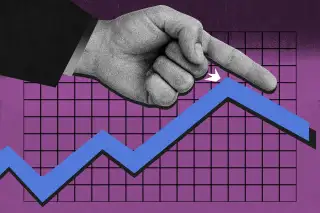How the Banking Crisis Could Help Fix Inflation — Without More Interest Rate Hikes

Is the end of interest rate hikes around the corner? It’s possible.
Recent comments from Federal Reserve Chair Jerome Powell suggested that the economic damage caused by the collapse of Silicon Valley Bank might allow the Fed to slow down on rate hikes. Here’s what you need to know.
What’s going on
On Wednesday, the Federal Reserve Board of Governors announced its ninth consecutive interest rate hike — part of its ongoing battle with stubbornly high inflation. The goal is to slow the economy down and rein in inflation, without dipping us into a recession or causing unnecessary harm to consumers and businesses.
The Fed signaled that just one more hike may be in the cards this year. This is a departure from Powell’s previous indications that the central bank might have to raise rates higher than expected, and keep them higher for longer, to get prices under control.
In a press conference Wednesday, Powell told reporters that the recent turmoil in the banking system might actually have the same effect on the economy as a rate hike.
“The events of the last two weeks are likely to result in some tightening of credit conditions for households and businesses, and thereby weigh on demand, on the labor market, and on inflation,” he said. “Such a tightening in financial conditions would work in the same direction as rate tightening.”
That’s because tighter financial conditions make money harder to borrow, while a rate hike by the central bank makes money more expensive (and in a way, harder) to borrow, too.
“As a matter of fact,” Powell added, “you can think of [these conditions] as being the equivalent of a rate hike.”
What the experts are saying
Market experts agree with Powell’s assessment. In a blog post on Wednesday, economists from Pimco said the recent stress in the banking system will slow economic activity and inflation, “resulting in the Fed having to do less to sufficiently tighten financial conditions.”
“As a result,” they added, “the Fed has likely moved closer to the end of the hiking cycle.”
In a research note on Monday, strategists from Goldman Sachs suggested that “tighter lending standards resulting from the banking stress” could be equivalent to the effect of a rate hike as high as half a basis point.
What it means for you
Investors have been eagerly awaiting the end of the Fed’s tightening cycle. Even if rates remain high for a period of time, the end of rate hikes means the central bank has more confidence in the trajectory of the economy.
It also means that an era of lower interest rates may be on the way — eventually. Those low rates trickle down to consumers in the form of lower credit card APRs, lower mortgage rates and even lower rates for auto loans.
But keep in mind: No one has a crystal ball when it comes to the economy, and Powell has acknowledged that it’s still too soon to make any assessments about how damaging the bank crisis has been “with any precision whatsoever.” If economic conditions change, the Fed will change course too — and that may mean more rate hikes.
The Fed Just Raised Interest Rates Again Despite Recent Bank Failures. Here's What It Means for You
Bank Failures Explained: Answers to 6 Big Questions About What Happened and What's Next
Social Security Recipients Shouldn't Count on Another Huge Raise Next Year